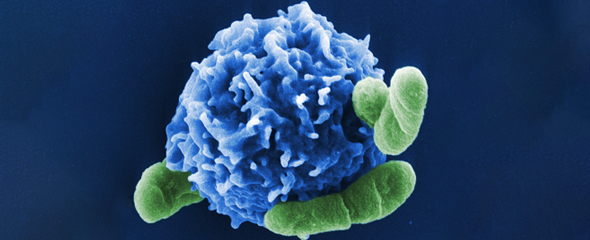The regulatory T cells (or "Tregs" for short) play a very important role in our immune system: They teach other immune cells which dangerous invaders to attack and which harmless to ignore. In doing so, the Tregs enable the immune cells to be tolerant to foreign antigens such as components of certain foods, pollen, animal hair, but also harmless microorganisms. In the absence thereof, allergies and autoimmune diseases would increase dramatically. "It was previously known that Tregs are produced particularly efficiently in the gut-draining lymph nodes. This demonstrates the important and well-balanced defence function of the intestinal immune system, which accounts for a large part of the entire immune system of our body," says Prof Jochen Hühn, who is the head of the "Experimental Immunology" department at the HZI. But it had not been studied in detail how these regulatory cells are equipped with their tolerogenic properties in the gut-draining lymph nodes.
Together with colleagues from the HIRI, scientists at the HZI could recently show in a mouse model that the gut-draining lymph nodes receive their characteristic properties shortly after birth. "We are born almost sterile. Already in the first few days after birth, very rapid colonisation by the first microbes takes place. This early-infantile imprinting teaches the gut-draining lymph nodes about their normal status, to which they can return after an infection," says Dr Jörn Pezoldt, scientist in Jochen Hühn's team and the principal author of the study.
The scaffold cells of the lymph nodes play a special role in the imprinting of the gut-draining lymph nodes by the microbes. While the significance of this cell type was nearly ignored in the past, an increasing number of studies shows that these cells are very important for the modulation of highly specialised immune responses. "The scaffold cells are influenced directly after birth by the colonisation of the first microbes in the intestine and retain this memory throughout their lives. Fixed firmly in the tissue of the lymph nodes, these cells are immobile, but can pass on their early imprinting in the form of information to other cells of the immune system, which migrate into the lymph nodes via blood or lymphatic vessels,” says Dr Maria Szente-Pasztoi, who is principal author of the study as well. "This is a very clever strategy: The microbial community in the intestines basically equips the scaffold cells to act as control centres that spread important information to other immune cells for defence."
The researchers gained these important insights in cooperation with Dr Antoine-Emmanuel Saliba, who is a scientist at the HIRI in Würzburg. The use of single-cell RNA-sequencing makes it possible to examine active genes in a single cell. "The analysis of the scaffold cells of the gut-draining lymph nodes on a single-cell level showed that these cells are very heterogeneous and only individual subpopulations have their unique properties stably imprinted by the initial contact with the microorganisms. This allowed us to show that the transcriptional signature is defined by the microbial flora," Saliba says.
The results of the scientists corroborate the fact that contact to a normal microbial colonisation in the early-infantile phase is very important for the development of a healthy immune system. Future research may address questions like how the lifelong properties of lymph nodes might be changed by various early-childhood influences such as a low germ environment due to antibiotics, severe infectious diseases or growing up in an overly sterile environment.
Original publication:
Jörn Pezoldt, Maria Pasztoi, Mangge Zou, Carolin Wiechers, Michael Beckstette, Guilhem R. Thierry, Ehsan Vafadarnejad, Stefan Floess, Panagiota Arampatzi, Manuela Buettner, Janina Schweer, Diana Fleissner, Marius Vital, Dietmar H. Pieper, Marijana Basic, Petra Dersch, Till Strowig, Mathias Hornef, André Bleich, Ulrike Bode, Oliver Pabst, Marc Bajénoff, Antoine-Emmanuel Saliba, Jochen Hühn: Neonatally imprinted stromal cell subsets induce tolerogenic dendritic cells in mesenteric lymph nodes. Nature Communications 2018, DOI: 10.1038/s41467-018-06423-7
Helmholtz Institute for RNA-based Infection Research:
The Helmholtz Institute for RNA-based Infection Research (HIRI) was established in May 2017 as a partnership between the Helmholtz Centre for Infection Research (HZI) and the Julius-Maximilian-University of Würzburg (JMU). HIRI is the first research institution worldwide bridging the fields of RNA biology and infectious disease. www.helmholtz-hiri.de
